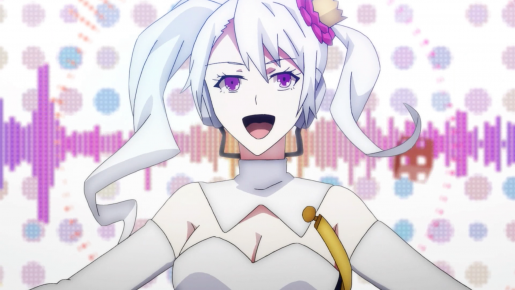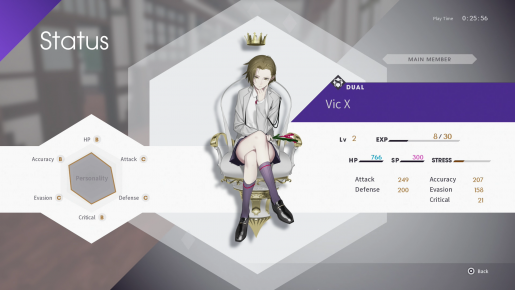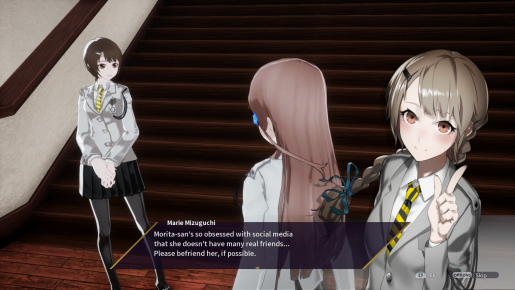Long term readers no doubt recognize my name from at least one of my reviews. In my tenure at Just Push Start, I don’t think any review was harder than The Caligula Effect. The struggle I faced came from the polarizing experience. As amazing as the story was, gameplay was just as frustrating and disappointing. With The Caligula Effect making its way to PlayStation 4, Switch and PC, it’s a chance to correct errors and bring gameplay more in line with the stories overall quality. Can The Caligula Effect: Overdose make up for past mistakes or is it broken beyond repair?
The Caligula Effect: Overdose takes place in the virtual world known as Mobius. This paradise was created so people could escape the pain and find some level of happiness. If it sounds a lot like the premise of a Persona game, that is probably due to Tadashi Satomi, whom worked on Revelations: Persona, Persona 2: Innocent Sin and Eternal Punishment.
What makes the story so fascinating is not just the core Go-Home Club’s struggle to return to reality, but the Ostinato Musicians reasons for siding with the co-creator of Mobius, μ. In exchange for aiding and protecting μ, they were granted their hearts desire. Most of these are not simple things, but rather fairly complex issues stemming from real issues from an even more real world. Even if you don’t side with or even agree with their thought process, it’s easy to understand their perspective and at least emphasize with their struggle. Even if that struggle is a lot of fun, gameplay remains frustrating.
Part of what made The Caligula Effect so awful was the imaginary chain system. As cool as the idea is, the execution remains as frustrating and pointless as it ever did. Instead of inputting a deciding which attack is best, imaginary chain pushes players to create a series of attacks in perfect harmony. To achieve this, you’re expected to watch a video that predicts the future at some level of accuracy, with the ability to change the timing or how moves mesh together. So, maybe you upper cut an enemy, another person shoots them in the air and then someone blows them up shortly after crashing into the ground. It sounds great, it just takes too long and isn’t accurate enough to be useful.
It wasn’t uncommon for my predictions to have a 95 percent chance of being accurate and then get screwed by that remaining 5 percent. No matter how likely something is, it’s always possible to end up on the losing end and nothing will prevent it from constantly working against you, it just isn’t fun or for that matter, plausible. Here in lies the issue with timing out attacks or planning for the future.
One mistake can ultimately screw everything up. If you miss a key element, like maybe you shoot someone, hit all five shots and then miss the launching attack, any moves you set to shoot them in the air will miss, unless they’re standing in the attacks trajectory. If this isn’t confusing enough, anecdotal evidence suggests the given rate is not as accurate as it claims. Not only did it happen far more often than numbers suggest it should’ve, something that is again entirely possible given how probability works, the very first time it happened I instantly remembered why I hated the combat system the first time.
In addition to potentially throwing off your attacks, any change can cause a massive disruption in your plan. Another, equally annoying, mechanic is everything being set in stone. So, maybe you attack an enemy a number of times, tell someone else to attack and on their second attack they die because you ended up landing more hits or enough of them were critical to defeat a foe. Instead of your allies adjusting to a different target, they will shoot at absolutely nothing if you tell them to.
After some while players will come to accept it’s faster and easier to just guess and have the most predictable course of action. So, even if nothing goes according to plan, these errors won’t negatively impact your commands. Given this makes imaginary chain totally and completely pointless, it becomes a system that, if nothing else, gives players an idea of what the original was going for, even if it continued to fail to accomplish it.
Regardless of how bad combat remains, The Caligula Effect: Overdose does offer some welcome improvements. Not only is the UI a lot cleaner, simpler and more effective, a lot of the performance issues are gone. The fluidity makes for a better overall experience, even if it remains rather dull looking and lifeless.
Verdict
The Caligula Effect: Overdose is pretty much the same game, just with more content and fewer technical issues. Considering the combat remains extremely frustrating and ultimately rather pointless, it continues to hold back one of the most interesting stories I’ve seen in a game. Given that the overall experience is a bit better, it makes it easier to overlook these issues, just like it makes sense a Vita game would not quite live up to the expectations of a native PlayStation 4 game, it’s just frustrating. But, since there is more story, the experience is better and there are some other minor tweaks, at least this time I can better recommend it.
[Editor’s Note: The Caligula Effect: Overdose was reviewed on PS4 platform. The game was provided to us by the publisher for review purposes.]





